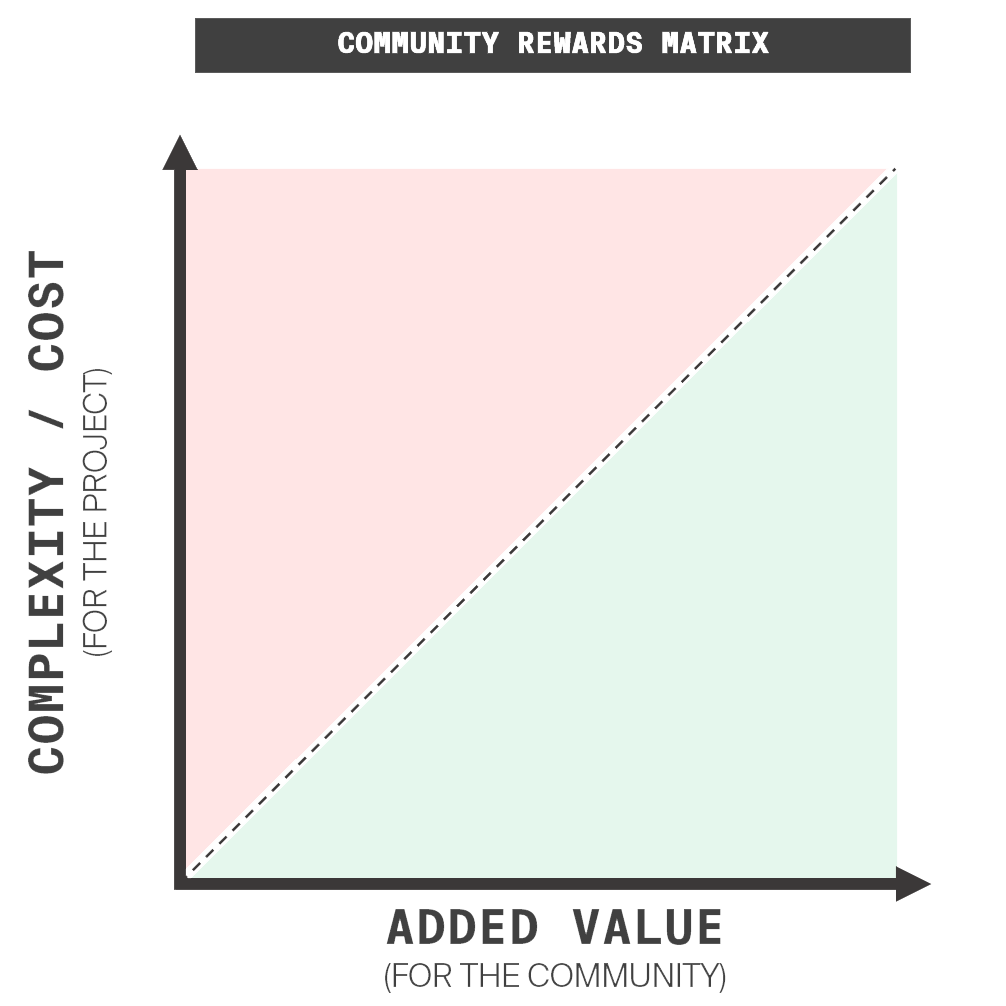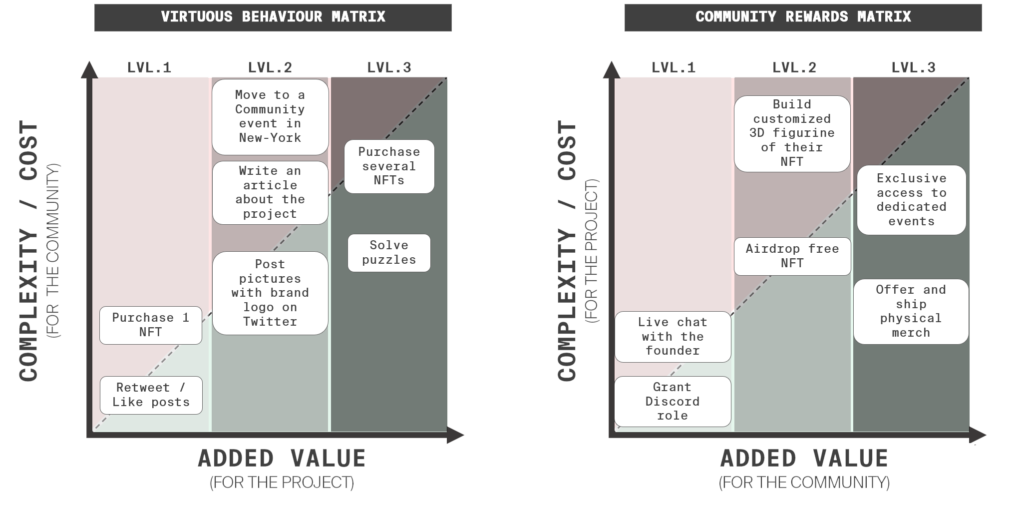How to convert a newcomer into hardcore community member?

This article discusses part of our strategic coaching approach to structure community engagement, build member loyalty, and offer utilities that really make sense. This approach aims to answer the following questions:
Overview
This method is based on the following steps:
- Define what your project needs
- Define virtuous behavior
- Define rewards
- Organize Rewards and Virtuous Behaviors into 2 distinct matrices
- Structure commitment Levels (Membership Tiers)
1 – What does your project need?
Here are the 4 components that 99% of NFT projects are looking for. Of course, this list can be extended or adjusted depending on the context:
- Money
- Visibility
- A close-knit community
- Free time to get on with delivery
2 – What is a virtuous behavior?
A virtuous behavior is an action done by one or several of your community members that supports your project in one or several areas mentioned in the list above. There are many possible behaviors, and they should be defined individually for each project, but here are some of the most common virtuous behaviors your project may benefit from:
- Being a spokesperson
- Owning one or more project assets
- Creating original content aligned with the project’s values
- Helping other community members
- Bringing friends in the project
3 – What are rewards?
Rewards most often correspond to your NFTs’ utilities, but they are not limited to that. Rewards correspond to any form of compensation you can offer your community to thank them for their action and support.
Rewards can be organized into four main categories:
- Offer an exclusive, limited, or personalized item (physical or digital)
- Give members the chance to enjoy extraordinary experiences (side events, meetings with artists, trips, etc.)
- Give members decision-making power in the project
- Various forms of VIP treatment (preview access, badges, social recognition, etc.)
4.1 – Virtuous behavior matrix
We structure this on 2 axes:
1/ Complexity: how much commitment does it require from community members?
Each behavior that could benefit your project should be estimated based on the level of engagement it requires:
- Simple: Like, retweet, share content on a social network
- Medium: Comment about content
- Advanced: Write an article or create User Generated Content
- High: Move geographically or spend money
Not all your community members will be able to put money into your project or consider moving abroad to meet other community members… this has to be gradual.
2/ Added value: What does this bring to the project for at least one of the above-mentioned points (money, visibility, community cohesion, etc.)?
Note that a complex task is not necessarily one with high added value, so it’s best to focus as much as possible on tasks with high added value and low complexity, even if most tasks follow the central axis.
In concrete terms, we’ll organize all the “behaviors to reward” on a relatively simple matrix and then sort them in an X order (Value) and a Y order (Complexity) like this one:

4.2 – Rewards matrix
This matrix is used a second time, this time to arrange the community rewards. The axes are identical, but they offer a different perspective on virtuous behaviors.
- Value: The value this reward brings to the community. This may be financial, but more often than not, it is perceived.
- Complexity: The logistical complexity of implementation and/or the associated cost to the project.

Once the matrices have been finalized, we should end up with something that looks something like this.

Now, how do we structure it to create the desired dynamic within the community?
5 – Building Community Thresholds
These levels allow us to organize and reward each type of member according to their commitment while showing them what additional rewards they could benefit from if they were just a little more active.
In the two matrices above – virtuous behaviors / community rewards – we introduced this notion of levels. Each level (generally from 3 to 5) will group together a certain number of rewards and behaviors that we wish to encourage.

Conclusions
The advantages of this methodology are manifold:
- Offer a wide variety of utilities to members of your community.
- Encourage community involvement at all levels.
- Consider the different forms of added value a community member can provide.
- Take into account and onboard community members, including “non-holders” of your NFTs.
Using this methodology and applying it correctly ensures that your community members are rewarded for their involvement and incentivized to do more.
The link between rewards and virtuous behaviors is nothing less than the DNA of your relationship with your community.
Forget the badges and roles granted on Discord, which serve no purpose other than to flatter the egos of a few members, and let’s finally offer utilities that will bring value at least equivalent to what the community brings to the project.
In the early days of NFTs, a relatively popular project called MyCryptoHeroes had as its slogan:
All the time and passion you invest into the game will turn into real assets.
MyCryptoHeroes – 2018
They captured the essence of what rewarding a community truly means.

